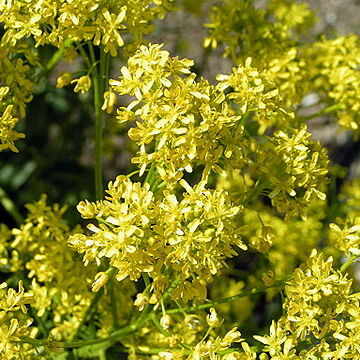Herbs annual, biennial, or perennial, often glaucous. Trichomes absent or simple. Stems erect, simple at base, paniculately branched above. Basal leaves petiolate or rarely sessile, rosulate or not, simple, entire, dentate, or pinnately lobed. Cauline leaves sessile and auriculate, sagittate, or amplexicaul at base, rarely petiolate and attenuate, entire or dentate. Racemes many flowered, ebracteate, forming panicles, elongated considerably in fruit. Fruiting pedicels filiform, often thickened and clavate at apex, reflexed. Sepals ovate or oblong, erect or ascending, base of lateral pair not saccate. Petals yellow, as long as or longer than sepals; blade obovate, spatulate, oblong, or oblanceolate, apex obtuse or subemarginate; claw absent. Stamens 6, slightly tetradynamous; anthers ovate or oblong, apiculate or obtuse at apex. Nectar glands confluent, or 4 and median and lateral pairs distinct. Ovules 1(or 2) per ovary, subapical. Fruit indehiscent, samaroid siliques or silicles, oblong, ovate, obovate, cordate, elliptic, oblanceolate, spatulate, or orbicular, strongly angustiseptate, sessile, prominently winged all around or distally, 1(or 2)-seeded, glabrous or hairy, smooth; seed-bearing locule papery or corky, prominently or obscurely 1-or 3-veined, sometimes keeled or shortly winged; valves and replum united; gynophore, style, and septum absent; stigma capitate, entire. Seeds wingless, narrowly oblong, plump; seed coat smooth, not mucilaginous when wetted; cotyledons incumbent or accumbent.
Sep divergent, somewhat unequal; pet yellow, narrowly obovate, exceeding the sep; short stamens flanked and subtended by a pair of confluent glands; each pair of long stamens subtended by a single gland; ovary flat, with a single locule and ovule; stigma sessile, 2-lobed; fr indehiscent and somewhat samaroid, compressed contrary to the normal position of the replum, with strongly flattened valves; seed single and median, replacing the replum; herbs, usually tall, with leafy, branching stems. 60, Eurasia, n. Afr.

